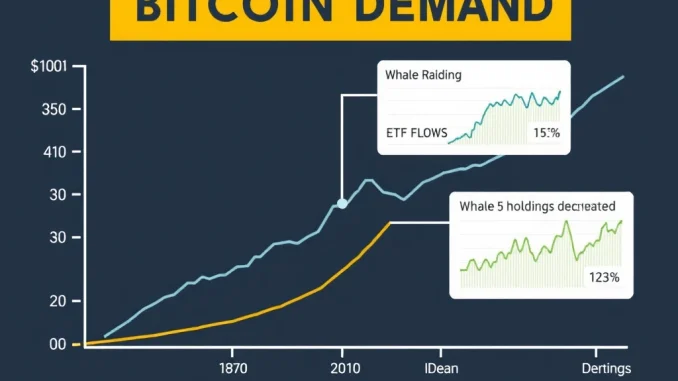
Is the intense appetite for Bitcoin finally starting to wane? Recent CryptoQuant data suggests that the strong wave of Bitcoin demand that propelled the market upwards might be losing steam. Understanding these shifts in on-chain data is crucial for anticipating potential market movements and Bitcoin price trends.
What Does CryptoQuant’s BTC Analysis Tell Us?
According to Julio Moreno, Chief Analyst at CryptoQuant, several key indicators point to a slowdown in the pace of accumulation for BTC analysis. While demand hasn’t disappeared entirely, its growth rate has significantly decreased from recent peaks.
Let’s break down the core data points highlighted by the CryptoQuant analysis:
- **Spot Demand Slowdown:** Over the last 30 days, spot demand for Bitcoin increased by roughly 118,000 BTC. While this is still substantial, it represents a notable drop from the peak increase of 228,000 BTC recorded around May 27th.
- **Whale Activity Decelerates:** The growth rate in holdings by large players (whales) has also cooled. Month-over-month, whale holdings grew by 1.7%, down from a previous rate of 3.9%. This indicates less aggressive accumulation from major holders.
- **US ETF Inflows Decline:** Purchases from US-based Bitcoin ETFs, a significant source of recent demand, have seen a sharp reduction. Daily purchases fell from an average of 9,700 BTC to just 3,300 BTC. This decline in institutional interest is a key factor in the overall softening of Bitcoin demand.
- **Short-Term Holder Holdings:** The amount of BTC held by short-term holders has decreased, falling from 5.3 million BTC on May 27th to 4.5 million BTC currently. This suggests some recent buyers may have sold, contributing to less holding pressure.
How Could Cooling Demand Impact Bitcoin Price?
A sustained period of weaker Bitcoin demand can naturally put downward pressure on the Bitcoin price. The CryptoQuant analysis highlights potential support levels based on on-chain data, specifically realized prices.
According to Moreno, if demand continues to weaken, the market could find support around the $92,000 level. This is based on aggregated realized prices from various on-chain cohorts, representing the average cost basis for different groups of investors.
However, the analysis includes a crucial caveat: if the $92,000 support level fails to hold, the Bitcoin price could potentially dip further, with the next significant support area identified around $81,000. Monitoring how BTC analysis evolves based on these support levels will be essential for traders and investors.
What Does This On-Chain Data Mean for You?
This on-chain data provides valuable insight into the current state of the market’s underlying dynamics. While a slowdown in Bitcoin demand doesn’t guarantee a price drop, it signals a potential shift in market momentum after a period of strong growth.
It underscores the importance of watching key indicators like ETF flows, whale movements, and aggregate investor cost bases as revealed by CryptoQuant and other BTC analysis platforms. These metrics offer a look beyond simple price charts, showing what different market participants are actually doing with their Bitcoin.
Summary: Keeping an Eye on the Data
The latest CryptoQuant data presents a clear picture: the pace of Bitcoin demand growth has decelerated across key segments, including spot buyers, whales, and US ETFs. This cooling off, while not necessarily signaling a major downturn yet, introduces potential headwinds for the Bitcoin price.
Analysts are now pointing to on-chain support levels like $92,000 and potentially $81,000 as crucial zones to watch if this trend continues. For anyone involved in the market, paying attention to this on-chain data and BTC analysis is more important than ever to navigate potential volatility and understand the market’s foundational shifts.



